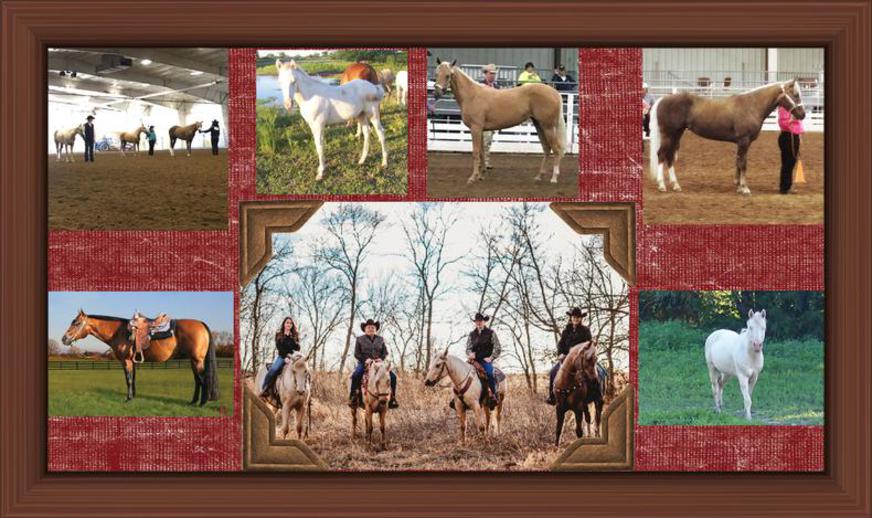Catching Your Horse
by Karen Tharp on 07/29/11
Catching your horse
We
handle all the horses here at Rising Sun Stables every day, this makes catching
them very easy. Most horses can be trained to allow a handler to catch them. The job is much easier when catching and handling is done correctly when
they are still foals. But even an older, difficult horse can be transformed
from evasive runaway into follower if the handler is willing to become a leader
who takes the time to understand the horse.
What makes a Horse Hard to Catch?
The
first step to understanding the elusive horse is determining what drives the
horse away from his handler.
Is
the horse afraid to leave the herd? If horses are housed in a herd situation,
their strongest instincts are to stay with the herd, whether the herd is inside
the barn or consists of two or three buddies out in the pasture. When we take
the horse away from the herd, where he's comfortable, that may create some
anxiety because we're basically taking him away from where his instincts tell
him it's safest to be.
Did
the horse have a bad first experience with being caught? A foal may never have been halter trained,
then the veterinarian comes out at 6 weeks of age, and the horse is caught for
the first time, He gets wormed, vaccinated and restrained; that's a fearful experience
for the foal and not an ideal first way to handle a horse. Those horses can
then be difficult to catch, needle-shy and fearful because that's been their
first experience with restraint."
Does
the horse lack good training? Many horses run away because they've not been
properly schooled to respond to a handler's commands.
Does
the horse receive negative reinforcement? Clumsy handling, being put to work,
or undergoing shots, worming or other unpleasant procedures every time the
horse is apprehended reinforces his distrust of humans.
Does
the horse receive inappropriate positive reinforcement? Some horses learn that
if they evade their handlers, they're offered a bribe. Soon it becomes a game.
Although
it may be impossible to figure out why a horse acts the way he does, it is
helpful to know whether the cause is due to fear, insufficient training,
handler error or a combination of all three.
Regardless,
the second step in correcting runaway behavior is careful consideration of each
cause and then making the appropriate adjustments toward a better partnership.
This is done by establishing trust, reshooting in the basics and/or learning
better handling techniques.
Restoring Trust
For
a fearful horse, or one whose experiences after getting caught are primarily
negative ones, the handler must gain the horse's trust and confidence. Restore
the relationship by giving the horse positive experiences. Handle him without
demanding anything from him. Spend more time not catching him and taking him
away, but just catching and handling him, giving him a pleasant experience. In
time he will associate you with the pleasant experiences as well as other
experiences. Do something nice like
grooming him, giving him a scratch, or just approaching him and handling him.
This
method is also applied to the horse that's afraid to leave his buddies.
Accustom the horse to being taken out of the herd with a good experience; hopefully,
the horse will soon develop enough confidence in you that he no longer sees you
as a threat to his herding instinct.
Practice
approaching the horse in a small enclosure, like a box stall, round pen or
paddock also helps. If you can't catch your horse in a box stall, you're not
going to be able to catch him in the field, Teaching them to allow you to approach
and handle-them, and giving them positive reinforcement, will help a lot when
you start having to catch them in different situations. By establishing this
relationship of being able to walk up to the horse, the horse should be able to
relate to the experience no matter where he is turned loose.
Retraining
For
the horse that chooses to ignore his handler's commands or that plays games in
hopes of getting a bribe, retraining in the fundamentals should correct the
problem. Because the goal of retraining the evasive horse is to create a horse
that will listen and obey his handler, use tools that make it easier for the
horse to understand: the lunge line, body language and, if possible, a round
pen.
If
you don't have a round corral, use the lunge line to teach him to come into you
at whatever gait you select. Have him change direction. Instead of doing
endless circles, train your horse to back up on the lunge line, go through
obstacles and over jumps. Ask him for different tasks, with plenty of praise
and rest so he gets his mind concentrating on you. Commands learned on the lunge
line should soon transfer to the horse in the pasture.
Work
with the horse through body language. Approach the horse with the idea that you
don't want to catch him that he ought to go away.
When
you push him away, you do it with shoulders square, your eyes on their eyes,
and all your motions square. As they go away, they will communicate back to you
when they're ready to renegotiate the deal. They do that with a series of four
or five gestures — a position of their ears, eyes, shoulders, neck, tongue,
lips, head. Once the conversation is complete about them wanting to return to
you, then you go passive instead of aggressive: Don't look them in the eye. Use
your body language to send the horse away, and then when the horse wants to
stop, use your body language to draw him back in. The horse will be naturally
drawn in to you.
Round Pen Training
The
round pen is an ideal situation where you can use your body language to
communicate with the horse. You learn in the round pen how to ask your horse to
go faster, slower, stop, turn, and to be alert to your body language. The same
basic principles can be accomplished without a round pen, but a round pen makes
it easier by taking away all the other man-made barriers that get in the way.
Teach
your horse the meaning of "whoa." A horse that is properly
taught 'whoa' will probably stand still in any situation, as long he's told
'whoa. That's a really useful word.
Better Handling
sometimes
the problem with the elusive horse is not so much the horse as it is how the
handler approaches or catches him. Don't approach a horse, especially a young
or inexperienced one, in what may be perceived as a threatening manner.
Approaching in a frontal position with direct eye-to-eye contact is very
predator-like, and the horse may turn and go away. If you approach the horse
casually with a side-long glance, the horse may allow you to approach. Sometimes
squatting down arouses a horse's curiosity, drawing him into you.
Never
chase a horse. You can't outrun him, and chasing may reinforce a fearful
horse's instincts that your actions are predatory or aggressive. Walk him down
instead. This usually works with a stubborn horse. You continue to walk slowly
after the horse. Eventually the horse knows what's going on and will tire of
the game. Sometimes a stubborn horse, if you just walk quietly along with him,
will just give up. Keep your cool; walking him down can take awhile.
Cornering
a wise old horse in a paddock or field might be OK, but it could be dangerous
with other types of horses. A frightened or nervous horse without a lot of
experience may run right over you to escape, because being trapped is not
naturally comfortable for a horse. If he runs over you once, he'll probably try
it again. Use the buddy system. Go up to another approachable horse and scratch
or pat him. Start walking him to the gate and the reluctant horse may follow.
Or, if the horses are buddies, walk the approachable horse over to the evasive
one and see if you can transfer control from one horse to the other.
Another
good way is to erect a catch pen or small paddock by the pasture gate and
gather the whole herd in there before cutting out the hard-to-catch horse. He's
probably going to follow his buddy in, and then you have a much smaller area to
deal with.
Think
ahead. Don't turn your horse out in a large field 30 minutes before you're
going to ride or before the veterinarian comes. When he's all full of energy,
you know he's not going to be ready to be caught for a couple of hours. That sets up a bad situation, and if the
horse refuses to be caught it reinforces bad behavior. Don't turn out a horse that has had very
little handling into a large area without a catch pen or companions to use as
lures.
Be Sensible and Sensitive
Never
punish a horse once you've caught him. Pulling him around on the halter, being
very aggressive with him or whipping the horse tells him. Never let me catch you again.
Be
sensitive to negative patterns. Part of the reason the horse may elude you is
because the only time you catch him is for work, so don't overdo retraining (or
training) your horse. Play with him, do other exercises, go on trail rides,
just don’t always make it work.
Always
reward your horse with a pat or encouragement. Be wary of food rewards. If we
always use food as a bribe, there may be times when the horse is not hungry and
the herd instinct is stronger than his desire to eat. . In addition, attempting
to lure one horse out of a herd by taking a bucket of grain into the area could
be dangerous. The horse you're trying to catch is probably not the No. 1
dominant horse. If you go in there with feed, the other horses are going to be
competing for the feed and, if anything, they're going to be chasing away the
horse you want to catch. That puts the handler in the middle of a bunch of
milling horses — a very bad position.
Retraining
the hard-to-catch horse may take a lot of time. Whether the horse has to
overcome a fear response or go back to square one for training, there simply
are no quick fixes. Each horse is also an individual; what works for one may
not work so well for another. But if you take the time to understand what your
horse's problem is, those fixes could last a lifetime.
So be patient and work toward your goal. Remember it may take a while. Enjoy your horse, stay cool in this heat. Have a great Day!










